

AIA Wisconsin Architects’
Work Honored for Excellence
State chapter selects 10 special projects
for awards
Ten buildings—from Pleasant Prairie, Wis., to Lima, Honduras—received 2003 Design Awards from AIA Wisconsin. The chapter reports that this year’s award-winning architecture “accentuates artful and innovative design solutions for a diverse range of projects,” all designed by chapter members. The projects’ architects, building owners, and general contractors received their awards at a May 21 ceremony at the Wright-designed Monona Terrace Community and Convention Center in Madison.
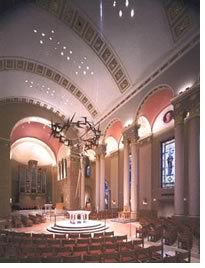 Honor
Awards
Honor
Awards
Cathedral of St. John the Evangelist,
Milwaukee, by HGA, with general contractor Grunau Project Management,
Inc., for Archdiocese of Milwaukee. Photo © John Korum.
After a fire, extensive rebuilding of its interiors significantly altered
this church’s 1853 original floorplan. HGA’s recent redesign
returned the altar to a place of prominence and proximity to parishioners
in the main worship space. This move created a place for a large choir
and orchestra and incorporated new lighting, sound, and mechanical systems
to support liturgical activities. The current transformation of the cathedral
marks the return to its rightful place as a “Jewel of the City.”
According to the jury, “The architects accomplished much more than
preservation. They intervened and changed the function of the church by
reconfiguring the interior and inserting new architecture at very precise
moments, which really helps to engage the congregation with the altar.”
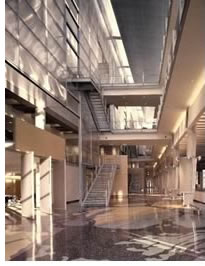 Engineering
Centers, University of Wisconsin-Madison, by architects Kohn Pedersen
Fox Associates and Flad & Associates, with general contractor J.P.
Cullen & Sons Inc ., for the State of Wisconsin Division of Facilities
Development. Photo © Scott McDonald.
Engineering
Centers, University of Wisconsin-Madison, by architects Kohn Pedersen
Fox Associates and Flad & Associates, with general contractor J.P.
Cullen & Sons Inc ., for the State of Wisconsin Division of Facilities
Development. Photo © Scott McDonald.
“For a university and institutional facility, this is a beautiful,
well detailed, very consistent and muscular building,” said the
jury. “It has a great presence and is well integrated with the campus.”
This project creates a dynamic flexible environment that integrates the
latest advances in research and education in a single new facility. The
three-story building organizes a series of interdisciplinary centers that
focus on fields such as nanotechnology, plasma manufacturing, and biomedical
engineering. Designed to meet these disciplines’ special needs,
the spaces range from open workshop areas and adaptable meeting rooms
to flexible lab spaces and Class-10 clean rooms.
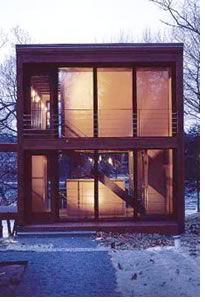 Aperture
House, Moose Lake, Wis., by Vetter Denk Architects, Inc., for an
anonymous client. Photo © John Vetter.
Aperture
House, Moose Lake, Wis., by Vetter Denk Architects, Inc., for an
anonymous client. Photo © John Vetter.
The solution for this project met the challenge to build affordably a
one-of-a-kind custom weekend retreat on an unforgiving site without sacrificing
design quality. Using the merits of pre-fabricated construction, the architects,
who also acted as construction supervisors, created a two-story, four-module
lakeside home that brings design sensitivity and flexibility to a typically
uninspired market. The project features clear views of the water and natural
surroundings, a ribbon band of clerestory windows, and an unencumbered
living area that resembles an urban loft in a rural setting. “If
I had a vacation house, I’d want one like this,” commented
one jury member. “It takes the notion of a case study on housing
from the 1950s and 1960s and really elevates that genre to an art form.”
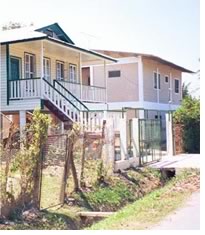 Merit
Awards
Merit
Awards
Banana Worker Housing, La Lima, Honduras,
by Arquitectura Inc., with general contractor Tela RR Co., for the Cooperative
Housing Foundation. Photo © Harry Van Oudenallen, AIA.
This project responds to the devastation caused by Hurricane Gilbert to
the entire banana-growing region of Honduras in 1988. The architect was
commissioned to design a pilot community, including 6,000 housing units,
for banana-field and plant workers. This ongoing, phased project lays
out the schematic infrastructure of neighborhoods, streets, schools, civic
structures, religious buildings, and parks. “The architect really
stepped up to create a very large vision for the community,” the
jury opined. “If there is any doubt about the potential influence
and power of Wisconsin architects, it has been put to rest with their
ability to influence something on this scale in Honduras.”
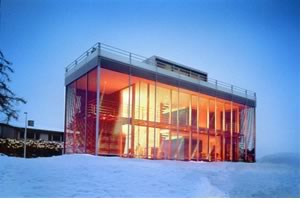 Janus
Kopf, Gossau Switzerland, by Gastrau Fuerer Associates as architect
and contractor for Marianne and Mathias Bruecker. Photo © Urs Wicki,
Catweazle Photography..
Janus
Kopf, Gossau Switzerland, by Gastrau Fuerer Associates as architect
and contractor for Marianne and Mathias Bruecker. Photo © Urs Wicki,
Catweazle Photography..
This single-family residence satisfies the client’s request for
a Modern design and still abides by local requirements for traditional-style
exteriors. The design composition marries two forms. To the north, the
home incorporates the local architectural guidelines and displays a conservative
face. To the south, the design expresses the desire for a Modern open
home that captures the view of the Alps. These two distinct elements,
one opaque and other translucent, evolve into final composition with three
distinct living levels. The house also incorporates maintenance-free materials
and sustainable design strategies throughout. “The architect was
able to respond to some very prescriptive requirements and still design
a more interesting, more creative modern home,” the jury concluded.
“It’s a great juxtaposition between the traditional house
forms and that of almost a civic-scale facade.”
 Max
Mitschjeta AG—Metal Fabrication, Gossau, Switzerland, by
Gastrau Fuerer Associates as architect and contractor for Max Mitschjeta
AG. Photo © Urs Wicki, Catweazle Photography.
Max
Mitschjeta AG—Metal Fabrication, Gossau, Switzerland, by
Gastrau Fuerer Associates as architect and contractor for Max Mitschjeta
AG. Photo © Urs Wicki, Catweazle Photography.
This project demonstrates an atypical approach to the design of a light
industrial facility. To complement the surrounding neighborhood, the architect
minimized the normally overbearing qualities of industrial buildings with
simple, clean details and a thoughtful use of materials. The building
is a titanium-clad Modern box that employs forms and details that are
non-abrasive in nature, respectful of its urban surround, and reflective
of its own industrial origins. “The strength of this project is
that a light industrial building can be thought of as a finely crafted
and detailed sculpture. It’s just cool to look at,” said the
jury. “This building is architectural design at a higher level than
might be normally expected for this type of project.”
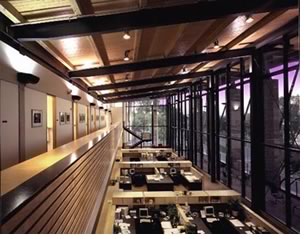 J.H.
Findorff & Son Inc., Madison, by Potter Lawson, Inc., with
J.H. Findorff & Son Inc. as general contractor and owner. Photo ©
Paskus Photography.
J.H.
Findorff & Son Inc., Madison, by Potter Lawson, Inc., with
J.H. Findorff & Son Inc. as general contractor and owner. Photo ©
Paskus Photography.
“This building demonstrates what a very good contractor and a very
good architect can do when they collaborate with one another,” the
jury enthused. “It becomes a lot easier for an architect or contractor
to state that they can create fine buildings if their own workspace is
finely executed.” Located on the edge of downtown Madison, the new
headquarters building rests on the same property where this construction
company was originally founded more than 110 years ago. The design takes
care to respect the contextual fabric of the historic industrial neighborhood.
This Modern building design expresses the profession of its owners and
the work they perform: The materiality and process of construction is
on display through finely crafted and exposed concrete, steel, stone,
and birch woodwork.
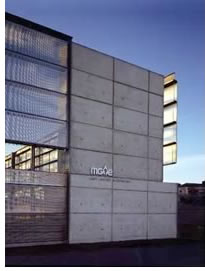 Madison
Gas & Electric East Campus Substation Screen Wall, Madison, Wis.,
by Potter Lawson, Inc., with Potter Lawson, Inc./J.H. Findorff & Son,
Inc. as general contractor, for Madison Gas & Electric/University
of Wisconsin. Photo © Scott McDonald.
Madison
Gas & Electric East Campus Substation Screen Wall, Madison, Wis.,
by Potter Lawson, Inc., with Potter Lawson, Inc./J.H. Findorff & Son,
Inc. as general contractor, for Madison Gas & Electric/University
of Wisconsin. Photo © Scott McDonald.
This project successfully resolved an issue of exposed infrastructure
in an increasingly trafficked pedestrian area. To conceal what was viewed
as unsightly, the architects turned the massive utility substation into
an object of beauty. Their design solution was to place a screen wall
of perforated stainless-steel panels to shield the 34-foot-tall substation
grid. As both screen and translucent veil, the panel system successfully
conceals and beautifies the necessary utility infrastructure. “This
is an innovative and creative project,” said the jury. “The
architects chose to elevate the project from what could have been a chain-link
fence around electrical equipment into a screenwall that lights up at
night and becomes an attractive symbol for the neighborhood and surrounding
area.”
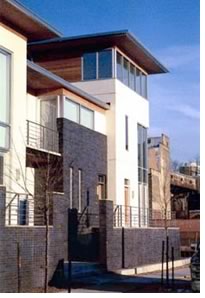 Beer
Line River Homes, Pleasant Prairie, Wis., by Vetter Denk Architects,
Inc., for River Homes Partners, LLC. Photo © John Vetter, AIA.
Beer
Line River Homes, Pleasant Prairie, Wis., by Vetter Denk Architects,
Inc., for River Homes Partners, LLC. Photo © John Vetter, AIA.
This project entails redeveloping a former industrial corridor along the
Milwaukee River into a high-quality residential and commercial neighborhood.
Although they range in price from accessible to high-end, each living
unit complements the historical context of the site. This project has
elevated a typically developer-driven market into an innovatively designed
urban neighborhood, with walkable connections to the city, river, and
surrounding areas. “This project reflects a successful collaboration
between architect and developer,” the jury commented. “They
worked together on this design to really push the creative edge and create
housing that is fresh and new in an up-and-coming industrial-edge area
of the city.”
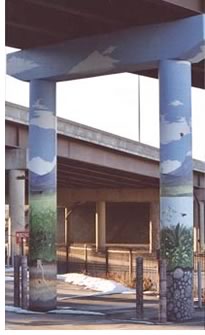 Special
recognition
Special
recognition
United Community Center Parking Area
3, Milwaukee, by J&V Affiliated, LLC, with general contractor
Payne & Dolan, for United Community Center. Photo © Cora Monis.
This parking area does a great deal more than fulfill a need for safe,
accessible parking. “This project is recognized for the involvement
of the neighborhood, the community, and the artists,” said the jury.
“The architect, as the linchpin, is being commended for community
advocacy and leadership.” The design solution offered a relevant
way to welcome clients and the surrounding neighborhood through the use
of colorful murals. Implementing the theme “The Wonders of Latin
America,” artists painted scenes indigenous to their own Latino
countries using the 30-foot support columns as their canvas. Student apprentices
from city schools helped make the parking lot an outdoor gallery that
is culturally linked to the community.
Copyright 2003 The American Institute of Architects.
All rights reserved. Home Page ![]()
![]()
 |
||
| Kirk Blunck, FAIA, Des Moines; Evett Ruffcorn, FAIA, Seattle; and Amy Stein, AIA, Philadelphia served on this year’s jury. Katherine Schnuck, AIA, Whitefish Bay, and Mark Kruser, AIA, Middleton, served as co-chairs of this year’s design program.
|
||